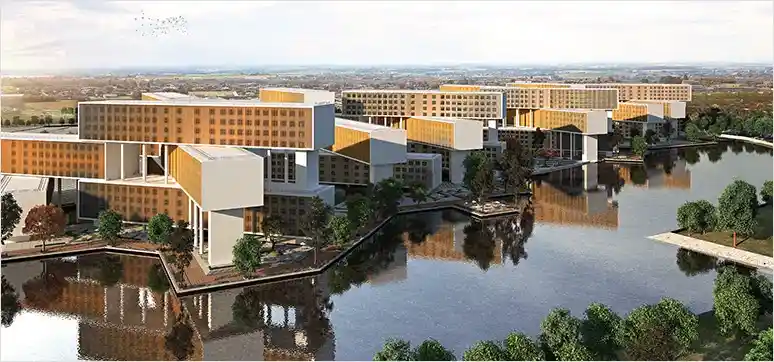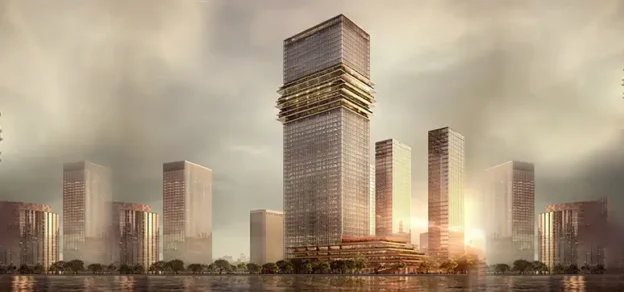Infosys Campus MIHAN is located in Nagpur, and sits in a ‘Special Economic Zone- SEZ’. Special Economic Zones are designated areas that possess special fiscal regulations different from the rest of the land with the aim of easing international trade and being conducive to foreign direct investment.
The client brief was simply ‘to create the world’s most sustainable office building’. Morphogenesis took this opportunity to test if a development of this scale could be net zero on water, energy and waste to landfill, with a future aim to develop a model for sustainable master-planning for larger sites.
The geology of the land played a key role in the morphological evolution; Nagpur lies in seismic zone II and the soil has a high bearing capacity. The building modules or tubes, are largely column free spaces that are stacked into a four floor format and are vertically connected through an atrium and a staircase. Each tube is swung at an angle of ± 22.5 degrees, this rotation in the stacking structure generates new ground at elevated levels. This dynamic morphology was a direct outcome of low seismic activity and the hydro-geological nature of the area.
The introduction of an earth sheltered, shaded and passively cooled landscape at a subterranean level integrates the different building blocks with the subterranean pedestrian circulation system. This is flanked with food courts and other public activities. These lowlying congregation spaces are shaded by the buildings on top and are thermally buffered by the surrounding land. This results in a large amount of public space being independent of mechanical cooling systems.
The plan evolved from the notion of understanding the capacity of the site; a capacity determined by functions like energy, water, geology of the land, along with essential rules of urban design pertaining to light, ventilation, and shading. Based on this a master-plan for a working population of 20,000 emerged, which is net zero on energy, water and waste discharge. Radial planning is used, in response to the natural topographical condition and the Western, North-Western and South-Western wind directions specific to the region.
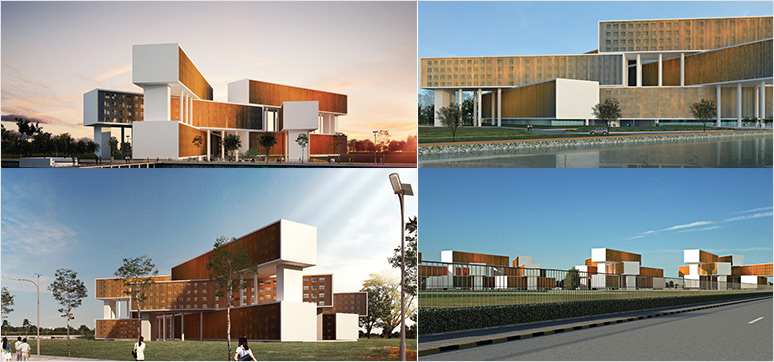
This radial grid strategy aids in bringing down the perceivable temperatures and creating a micro climate on site. The ± 22.5 degrees North orientation stems from Nagpur’s location on the Tropic of Cancer; this allows for 90 percent of the building to be day lit. Sixteen metre wide floor plates, solar protection strategies like façade shielding with fins, and mutual shading, proved to be an effective solution to ensure the building blocks are uniformly day-lit and completely glare-free.
The design of the built envelope was governed by the following parameters, such as solar control, glare control, distribution of daylight and heat loads.
Solar Control:
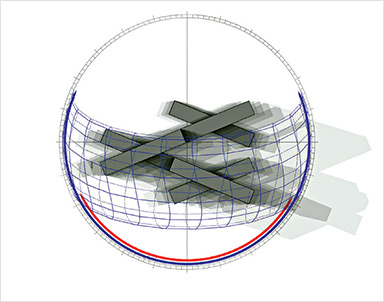
Solar shading design for a typical opening on each of the four orientations (NNW-SSE and NNE-SSW) was carried out. After calculations, it was concluded that 422mm deep vertical fins spaced at 600mm c/c could be adopted for North and North- East orientation as this solution helped maintain views across the entire height of the window while effectively shading the morning sun. Following the same methodology, 600mm wide fins spaced at an overall 600mm c/c proved to be optimum for North, North West facing windows. Solar controls for south façades were designed considering 21st December (winter solstice) for peak design parameters because the sun drops down to the lowest altitude levels (0.6° at 5.30pm). Here, the solar altitude was identified as the critical angle. It is important to highlight that Nagpur tends to see mostly clear sunny skies and so the tendency of experiencing glare is quite high.
A solution for this was to obstruct the bright sky view from the upper end of the window. Consequently, the window was divided in 2 equal parts – daylight window at 2.1m and vision window at sill level of 1.1m. While designing for the South, South-East windows, it was observed that vertical fins of depth and spacing of 600mm were effective for obstructing the sun after 11am till 5.30pm. Horizontal overhangs were explored for providing shade for the remaining morning period. The role of the shading devices was reversed for the south, south-west window where the vertical fins were effective from 9am to 11am and overhang helped distance the direct sun from the workstation.
Daylight Distribution and Glare Control:
South facing windows suffer more from direct solar radiation for most part of the day. Despite frosting the daylight panel, the high levels of external illuminance could lead to the panel itself becoming extremely bright. This aspect was countered through light shelves at 2500mm which obstructed the direct view of the daylight panel from the occupant’s seated level. For northern orientations, the daylight available is diffused and therefore glare-free. This fact was exploited by the addition of internal light shelves on the northern façades which were expected to increase daylight distribution inside the workspace. Further extending the light shelves by another 600mm towards the outside led to a significant improvement in the daylight levels.
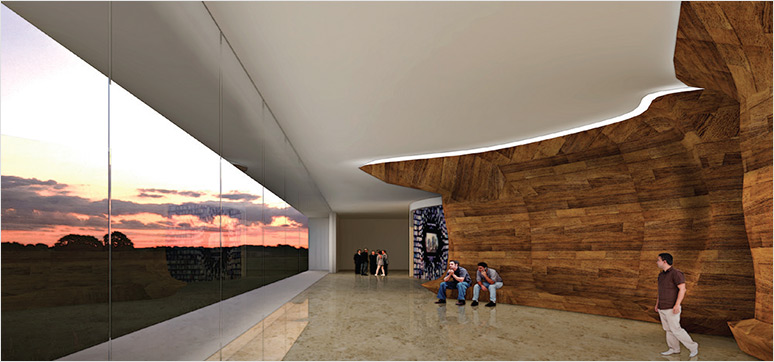
Thermal Efficiency:
The heat gain process through opaque elements like walls and slabs of a building mainly comprises heat gain through conduction. Transparent building elements, on the other hand, have higher vulnerability to heat gain through solar radiation in addition to conductive heat gain. Heat gain from solar radiation is based on the solar heat gain factor (SHGC) of the glass which, in turn, depends on the specifications of the glass and on the angle of incidence. Owing to the solar shading design, the effective SHGC in this case was much lower than the maximum SHGC which played a significant role in reducing the overall heat gain from incident solar radiation. Finally, the solar heat gain for the entire building was calculated and resulted in an overall thermal efficiency of 0.79W/sq.ft.
The use of passive strategies though the project aids in reducing energy requirements to one fifth of the consumption of a typical office. This reduced requirement is serviced by a 30 acre on-site solar plant, resulting in zero energy from the grid. Zero water dependence is achieved by creating a reservoir on site. Designed as a lake adjoining the existing water-tank in the West, this reservoir is fed by effective rainwater surface run-offs. Efficient system design ensures water management and the recycling methods reduce the water consumption by half. Bio-degradable waste disposal is addressed by a bio-gas plant and vermicomposting.
Infosys sets out to establish a new context in ‘the middle of nowhere’ for future projects in MIHAN and act as an iconic precursor for the area to be developed as a global hub of information technology.
QUICK FACTS
Project: Infosys Campus Mihan
Location: Nagpur, Maharashtra, India
Client: Infosys
Architects: Morphogenesis, Delhi
Built-up area: 8,25,000 sq. ft. (Phase1)
Site area: 142.0 acres
Consultants: LERA (Nayan B Trivedi)-Structure; Deep Roots (Rajalakshmi Iyer)-Landscape Design; McD BERL-Fire Fighting; Mcd Berl-MEP; Morphogenesis-Sustainability; Sobha-Facade; SG Equipments- Hospitality
Contractor: Sobha (Civil)
Status: In progress
